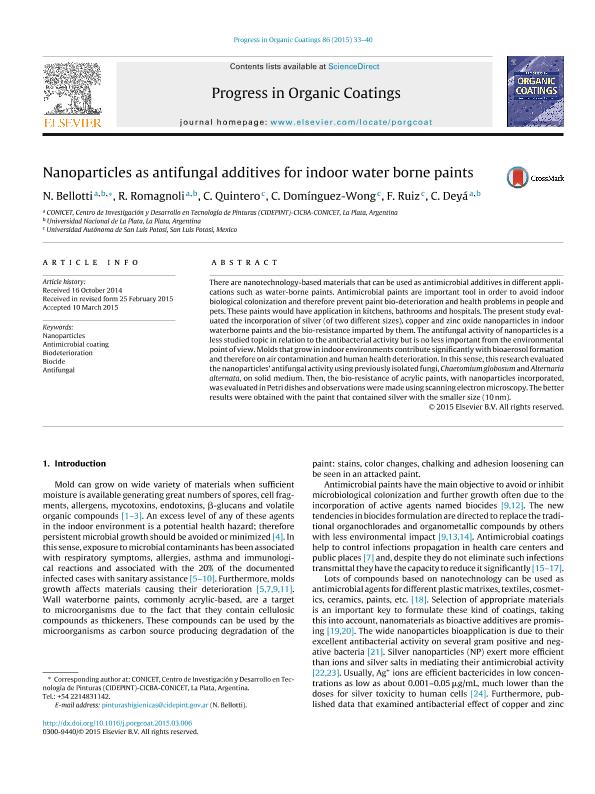Artículo
Nanoparticles as antifungal additives for indoor water borne paints
Bellotti, Natalia ; Romagnoli, Roberto
; Romagnoli, Roberto ; Quintero, C.; Domínguez Wong, C.; Ruiz, F.; Deya, Marta Cecilia
; Quintero, C.; Domínguez Wong, C.; Ruiz, F.; Deya, Marta Cecilia
 ; Romagnoli, Roberto
; Romagnoli, Roberto ; Quintero, C.; Domínguez Wong, C.; Ruiz, F.; Deya, Marta Cecilia
; Quintero, C.; Domínguez Wong, C.; Ruiz, F.; Deya, Marta Cecilia
Fecha de publicación:
04/2015
Editorial:
Elsevier
Revista:
Progress In Organic Coatings
ISSN:
0300-9440
Idioma:
Inglés
Tipo de recurso:
Artículo publicado
Clasificación temática:
Resumen
There are nanotechnology-based materials that can be used as antimicrobial additives in different appli-cations such as water-borne paints. Antimicrobial paints are important tool in order to avoid indoorbiological colonization and therefore prevent paint bio-deterioration and health problems in people andpets. These paints would have application in kitchens, bathrooms and hospitals. The present study eval-uated the incorporation of silver (of two different sizes), copper and zinc oxide nanoparticles in indoorwaterborne paints and the bio-resistance imparted by them. The antifungal activity of nanoparticles is aless studied topic in relation to the antibacterial activity but is no less important from the environmentalpoint of view. Molds that grow in indoor environments contribute significantly with bioaerosol formationand therefore on air contamination and human health deterioration. In this sense, this research evaluatedthe nanoparticles? antifungal activity using previously isolated fungi, Chaetomium globosum and Alternariaalternata, on solid medium. Then, the bio-resistance of acrylic paints, with nanoparticles incorporated,was evaluated in Petri dishes and observations were made using scanning electron microscopy. The betterresults were obtained with the paint that contained silver with the smaller size (10 nm).
Palabras clave:
Nanoparticles
,
Antimicrobial Coatings
,
Biodeterioration
,
Antifungal
Archivos asociados
Licencia
Identificadores
Colecciones
Articulos(CIDEPINT)
Articulos de CENTRO DE INV EN TECNOLOGIA DE PINTURAS (I)
Articulos de CENTRO DE INV EN TECNOLOGIA DE PINTURAS (I)
Citación
Bellotti, Natalia; Romagnoli, Roberto; Quintero, C.; Domínguez Wong, C.; Ruiz, F.; et al.; Nanoparticles as antifungal additives for indoor water borne paints; Elsevier; Progress In Organic Coatings; 86; 4-2015; 33-40
Compartir
Altmétricas



